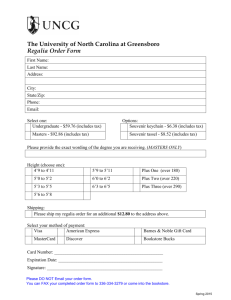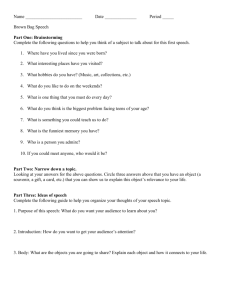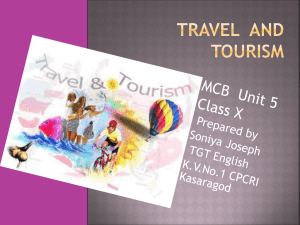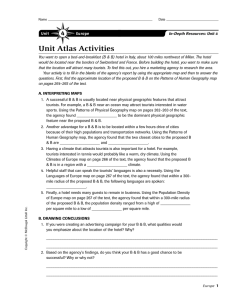Binary Logit analysis of souvenir design preferences by international Komsan Suriya
advertisement
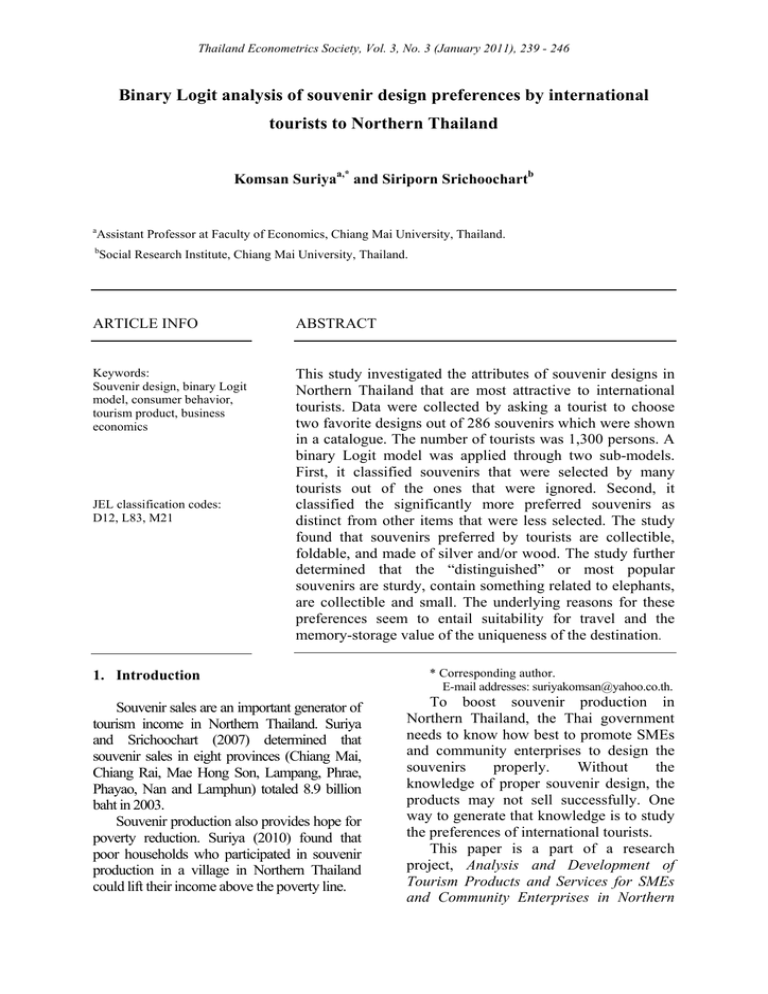
Thailand Econometrics Society, Vol. 3, No. 3 (January 2011), 239 - 246 Binary Logit analysis of souvenir design preferences by international tourists to Northern Thailand Komsan Suriyaa,* and Siriporn Srichoochartb a Assistant Professor at Faculty of Economics, Chiang Mai University, Thailand. b Social Research Institute, Chiang Mai University, Thailand. ARTICLE INFO ABSTRACT Keywords: Souvenir design, binary Logit model, consumer behavior, tourism product, business economics This study investigated the attributes of souvenir designs in Northern Thailand that are most attractive to international tourists. Data were collected by asking a tourist to choose two favorite designs out of 286 souvenirs which were shown in a catalogue. The number of tourists was 1,300 persons. A binary Logit model was applied through two sub-models. First, it classified souvenirs that were selected by many tourists out of the ones that were ignored. Second, it classified the significantly more preferred souvenirs as distinct from other items that were less selected. The study found that souvenirs preferred by tourists are collectible, foldable, and made of silver and/or wood. The study further determined that the “distinguished” or most popular souvenirs are sturdy, contain something related to elephants, are collectible and small. The underlying reasons for these preferences seem to entail suitability for travel and the memory-storage value of the uniqueness of the destination. JEL classification codes: D12, L83, M21 1. Introduction Souvenir sales are an important generator of tourism income in Northern Thailand. Suriya and Srichoochart (2007) determined that souvenir sales in eight provinces (Chiang Mai, Chiang Rai, Mae Hong Son, Lampang, Phrae, Phayao, Nan and Lamphun) totaled 8.9 billion baht in 2003. Souvenir production also provides hope for poverty reduction. Suriya (2010) found that poor households who participated in souvenir production in a village in Northern Thailand could lift their income above the poverty line. * Corresponding author. E-mail addresses: suriyakomsan@yahoo.co.th. To boost souvenir production in Northern Thailand, the Thai government needs to know how best to promote SMEs and community enterprises to design the souvenirs properly. Without the knowledge of proper souvenir design, the products may not sell successfully. One way to generate that knowledge is to study the preferences of international tourists. This paper is a part of a research project, Analysis and Development of Tourism Products and Services for SMEs and Community Enterprises in Northern K. Suriya and S. Srichoochart Thailand (Lanna) conducted in 2006 and 2007 in Chiang Mai, Thailand. We were interested in empirically determining the attributes of souvenirs that are most attractive to international tourists. We collected 286 pictures of various souvenirs and put them into a catalogue. Then we used the catalogue to ask the tourists what kind of souvenirs they preferred. We then looked at the details of each souvenir and specified its attributes. Using the Logit model, we could classify the favorable attributes out of the unwanted ones. We also extended the analysis to classify the popular attributes out of the unpopular ones. The results of this research were distributed to project staff in the second year of the research project when real prototypes were designed and used for further analysis. 2. Objective To investigate the favourite attributes of souvenirs destined for the international tourist market in Northern Thailand. 3. Conceptual framework Conceptual framework The theory of rational choice behaviour suggests that humans can rank their preferences and then make the choice that maximizes preference. In this study, we apply this concept to the selection of a new type of tourism service. A classic paper that applied the same conceptual framework is Domencich and McFadden (1975). The paper is distinguished among other classic papers in that it introduced econometric estimation which perfectly suits the theory. Although it was originally a study about urban travel demand, it also opened up the opportunity to investigate selection behavior in many other industries. This study follows the same conceptual framework. First, an individual has a utility level determined by attributes of souvenirs (x) 240 and his or her own personal characteristics (v). U i = f ( x, v i ) (1) The utility that that individual derives from choosing a preferred souvenir design is also determined by the preferable attributes of the design and the characteristics of the chooser. (2) U iP = f (x P , vi ) The utility that an individual gets from another souvenir design that he or she does not choose is defined as U NP which is determined by the attributes of the nonpreferable souvenir design and also the personal characteristics of the chooser. (3) U iNP = f (x NP , vi ) The decision of choosing the preferable souvenir design over the nonpreferable one must satisfy the condition that the utility that an individual gets from the chosen one is greater than the nonchosen one. (4) f (x P , vi ) > f (x NP , vi ) However, both preferable and nonpreferable souvenir designs may share some identical attributes (x1) whereas they present other different attributes (x2). Therefore, the attributes in equation (4) can be separated into two parts as follows: (5) f (x1P , x2P , vi ) > f (x1NP , x2NP , vi ) By an assumption of additive separable utility, the utility can be further separated into two parts. First the utility that an individual gets from the identical attributes and second the utility that he or she gets from the different attributes. This separation can be applied to both preferable and non-preferable designs. f (x1P , x2P , vi ) = φ1 (x1P , vi ) + φ2 (x2P , vi ) (6) ( ) ( ) ( ) f x1NP , x2NP , vi = φ3 x1NP , vi + φ4 x2NP , vi (7) Due to the fact that the chooser is the same individual for both preferable and non-preferable souvenir designs, the terms that represent the utility that he or she gets from the identical attributes cancel out. (8) φ1 x1P , vi = φ3 x1NP , vi ( ) ( ) Binary Logit analysis of souvenir design preferences by international tourists to Northern Thailand Therefore, the difference between both tourism services is reflected only in the different attributes. When an individual chooses a preferable souvenir design over the non-preferable one, it means that the utility that he or she gets from the different attributes of the preferable souvenir design exceeds the utility that he or she gets from the non-preferable one. (9) φ2 (x2P , vi ) > φ4 (x2NP , vi ) Rearranging equation (9) yields an expression whereby the difference between both utilities exceeds zero. (10) φ2 (x2P , vi ) − φ4 (x2NP , vi ) > 0 This conceptual framework allows a researcher to estimate the influence of attributes of souvenir design upon the choice behaviour of an individual using a Logit model. By setting the value of the dependent variable (y) to 1 (one) if an individual chooses a given souvenir design and to 0 (zero) if he or she does not choose it, the researcher can determine which attributes are influential in determining the preferences of international tourists for the new types of souvenir design. ⎧ P NP ⎪⎪1 if φ2 x2 , vi − φ4 x2 , vi > 0 (11) y=⎨ ⎪0 if φ x P , v − φ x NP , v ≤ 0 2 2 i 4 2 i ⎪⎩ ( ) ( ) ( ) ( ) 4. Methods of data collection Pictures of 286 souvenirs were put into a catalogue. During April to June 2006, the catalogue was presented to a total of 1,300 international tourists at Chiang Mai International Airport during his or her waiting time for the flight in the departure terminal. A tourist looked at the catalogue and then chose 2 favorite products. 5. Methods of data analysis Binary Logit model was applied to this study since the dependent variable has two values, 1 (one) if a tourist chooses a design and 0 (zero) if the tourist does not choose it. All 286 designs were presented to a 241 tourist at the same time in a catalogue. Only the two most preferred designs were chosen. Usually, the researcher should have two observations that have the value of a dependent variable as 1 (one) and the other 284 observations have the value of zero. However, this method will use a lot of resources such that an individual would have 286 observations. The number of tourists was 1,300 persons. Then 369,200 lines in the spreadsheet will be filled. When all 369,200 lines are presented, the technique of estimation is conditional Logit. However, we wished to keep the analysis simple using binary Logit to match the resource that we had at that moment. Therefore, the transformation of the values of dependent variables was conducted. By this transformation, only 286 observations were included in the model. The characteristics of the chooser were ignored to focus only on the attributes of the designs. The transformation was that we counted the frequency of being chosen of a souvenir design. If it exceeded a threshold which was 4 in the first model and 11 in the second model, we gave the value of one to the dependent variable. The threshold was set according to the distribution of the decision. The threshold of 4 divided all the souvenir designs into two almost equal sizes, 156 chosen and 128 non-chosen designs. This is because binary Logit model works best under the condition that the size of both sides of the observations containing the value of one and zero should be almost the same. The threshold of 11 was good for the separation of the distinguished designs out of normal designs. Around 20 percent of the designs were classified as one. This set was small enough to represent the designs that are distinguished. However, the ratio is large enough for the binary Logit model to work well. A higher frequency may be good in representing the more distinguished designs but it may cause the K. Suriya and S. Srichoochart smaller ratio which leads the binary Logit model to work improperly. According to the estimation strategy mentioned earlier, the study consists of two models as follows. Model 1: Classification between favorite and unwanted attributes Dependent variable: The result of the decision of tourists upon each souvenir Y=1 for a souvenir that was chosen 4 times or more Y=0 for a souvenir that was chosen less than 4 times Independent variable: Characteristics of the souvenirs were listed to 26 attributes as follows. 1. 2. 3. 4. 5. 6. 7. Handmade Wooden Made of cloth Made of silver Made of other natural materials Designed based on nature Inclusion of local northern (Lanna) culture 8. Inclusion of central Thai culture 9. Hill tribe look 10. Religious 11. Contain picture, shape or symbol of elephant 12. Contain a word of “Chiang Mai” 13. Contain a word of “Thailand” 14. Small 15. Light 16. Sturdy 17. Round 18. Foldable 19. Bundling 20. Functional 21. Lucky symbol 22. Use for body 23. Collectible 24. Edible 25. Have sound 26. Vanishing when being used up 242 Model 2: Classification between popular and unpopular attributes Dependent variable: The result of the decision of tourists upon each souvenir Y=1 for a souvenir that was chosen 11 times or more Y=0 for a souvenir that was chosen less than 11 times Independent variables: Those 26 attributes of souvenirs which are used in the first model were also included in the second model. The estimation procedure of both models is clarified as follows. Step 1: Include all 26 independent variables into the model. Step 2: Estimate the model using Logit. Step 3: Exclude the most insignificant variable out of the model. The remaining variables are estimated using the Logit model again. Step 4: Repeat step 2 for another variable which is the most insignificant until every independent variable is significant, at which point the estimation stops. 6. Findings and discussion First, the findings of model 1 will be shown. After that, the results of model 2 will be displayed. Model 1: Classification between favorite and unwanted attributes By model 1, the classification between favourite and unwanted attributes, only five independent variables are significant at the last round of the estimation. They are souvenirs that are made of wood, made of silver, foldable, bundling and collectible. The estimation results are presented in table 1 and the marginal effects in table 2. Binary Logit analysis of souvenir design preferences by international tourists to Northern Thailand Table 1: Classification between favorite and unwanted attributes Variable Coefficient Std. Error z-Statistic Wooden 0.5391 0.3253 1.6572 Silver 1.0498 0.5863 1.7905 Foldable 1.1154 0.3204 3.4811 Bundling -1.8774 0.6632 -2.8306 Collectible 2.2951 1.066 2.1525 Constant -0.3600 0.2411 -1.4928 Observations with Y=0 128 Observations Observations with Y=1 156 McFadden R-squared 0.09 243 Prob. 0.0975 0.0734 0.0005 0.0046 0.0314 0.1355 284 Source: Estimation using logit model with Eviews 3.0 Table 2: Marginal effect of the favorite attributes Variable Collectible Foldable Silver Wooden Bundling Marginal effect 0.5738 0.2789 0.2625 0.1348 -0.4694 Source: Calculation based on change from X=0 to X=1. The most favorite attribute that attracts international tourists visiting Northern Thailand to select a souvenir is that it is “collectible.” This is only reasonable since the primary “duty” of a souvenir is to remind an individual of the trip that he or she made. Tourists collect souvenirs along their journeys for the purpose of having some memories of the places back to home. Moreover, they make a collection of souvenirs to present to other people that they have experienced the places. Good souvenirs must satisfy this demand. Key rings are thus immortal souvenirs. The second influential attribute is that the souvenir should be “foldable.” A tourist needs something that can be put into his or her luggage. The space of the luggage is unfortunately too limited to carry everything back to the home country. Buying things that are too big must be shipped by a container which is not comfortable both in the destination and home countries, involves additional expense, and runs the risk of loss or breakage. Therefore, tourists choose souvenirs which are foldable such that they can put them into the luggage easily and safely. The third attractive attribute is that it is “made of silver.” Chiang Mai is famous of its production of silverware. It is the only place in Northern Thailand where tourists can find good quality of silverware as well as excellently skilled silversmiths. Wua Lai has been the cluster of silverware production for more than 100 years. Ladies’ accessories made of silver are the most popular items that tourists choose. The fourth attribute that attract tourists is that the souvenir is “wooden.” Wood is valuable due to its rarity in the developed countries. Wood carving, e.g. small dolls, in those countries are replaced by resin. Even though resin imitates quite perfectly the surface of wood, it does not give the same feeling of touching real wood. Wood gives the feeling of nature by its cooling touch and rough surface. People who touch wooden products may feel like they are touching a tree and being close to nature. Provinces in Northern Thailand, especially Chiang Mai, Lampang and Lamphun are famous of their wood carving. They offer series of wooden products into the market K. Suriya and S. Srichoochart with various sizes from smaller ones which can be put into luggage to bigger ones that need shipping in containers. However, the study found not only favorite attributes but also significantly unwanted characteristics. One of the latter was “sold in a bundle.” Tourists prefer souvenirs that are sold as just one piece. If the souvenir is sold in a bundle, the probability of being chosen falls by about 47% according to the marginal effect. This is because selling in bundle implies that the quality is inferior. Moreover, most tourists do not need to have a lot of identical souvenirs. 244 Model 2: Classification between most favorite and just favorite attributes The second model emphasizes the attributes that make the souvenir “distinguished” or popular. The dependent variable represents that the souvenir is highly appreciated by tourists. Only around 20 percent of the souvenirs are classified as distinguished. Souvenirs are distinguished when they contain something related to elephants, small, sturdy and collectible. In contrast when they are sold in bundles, they are obviously unpopular. The estimation results are shown in table 3 and 4. Table 3: Classification between popular and unpopular attributes Variable Coefficient Std. Error z-Statistic Elephant 1.3842 0.6741 2.0534 Small 0.9497 0.4108 2.3118 Sturdy 1.9246 1.0658 1.8057 Bundling -2.1619 1.1783 -1.8347 Collectible 1.3638 0.6635 2.0554 Constant -3.2746 1.0644 -3.0763 Observations with Y=0 221 Observations Observations with Y=1 64 McFadden R-squared Prob. 0.0400 0.0208 0.0710 0.0666 0.0398 0.0021 285 Source: Estimation using logit model with Eviews 3.0 Table 4: Marginal effect of the popular attributes Sturdy Elephant Collectible Small Bundling Marginal effect 0.4812 0.3461 0.3410 0.2374 -0.5405 Source: Calculation based on change from X=0 to X=1. The most popular attribute that makes a souvenir distinguished is that it is “sturdy” or resistant to breakage or tearing. Tourists do not prefer souvenirs that are fragile. This makes sense in that tourists need to travel from place to place, carrying things with them. They need to rearrange the luggage often within a limited time constraint. Therefore, they prefer something that is resistant to this behavior. This is why souvenirs that are made of glass or fragile ceramic are not popular. Souvenirs that contain a “picture, shape or symbol of elephants” are the second most popular since elephants are representative of Thailand and Northern Thailand. The former flag of Thailand contains a white elephant on a red screen. Elephants served as living tanks in ancient wars. In the history of the North, elephants were important working animals in teak Binary Logit analysis of souvenir design preferences by international tourists to Northern Thailand forests. They also figure as a symbol in the Chiang Mai emblem. Today, they give joy to tourists watching them perform, play football and paint with their trunks. Size does matter, at least when it comes to souvenirs. Tourists need to put their purchases into luggage with limited space. Small souvenirs are obviously advantageous concerning this need of tourists. The key rings mentioned earlier are immortal in large part because they not only collectible but small. Tourists can purchase varieties of them to make a collection but sacrifice only little space in their luggage. Even though the attributes that were found in the second model are not a subset of the first model, two variables from the first model were captured in the second model. They are the souvenirs that are “collectible” and “sold in bundles.” These two variables show some robustness in both models. However, the other three variables that were added in the second model which are sturdiness, containing something related to elephants and small size share the same principle of missing variables from the first model. The unifying principle is traveling behavior. Tourists need not to worry about the fragility of things in the luggage. They have only limited space in the luggage. They find something that is unique of the destination to bring back to their home countries. A small souvenir is like a foldable one. Elephants also serve the demand of uniqueness of the destination and the nature as silverware and wooden souvenirs can be presented to tourists. Therefore, even though both models found different attributes, the principles underlying them are the same. 7. Conclusions This study has investigated the attributes that attract international tourists to Northern Thailand to select souvenirs. It separated the analysis into two parts. Part one was the search for the attributes that 245 make the souvenirs preferable. Part two was to find out which attributes make the souvenirs distinguished or popular. The study found that souvenirs that tourists prefer are collectible, foldable, made of silver and made of wood. The reasons lie behind the needs of travelers to collect something to remind them of the days of their trips, the limited luggage space available during travel, the fame of silverware of Northern Thailand, and the touch of nature. The study also found that souvenirs that are distinguished among other souvenirs contain something related to elephants; and are sturdy, collectible and small. The reasons are due to the worry of travelers about the damage to the souvenirs, the long history of elephants in the Thai context and the limited space in the luggage. The principle that can be concluded from this study is that good souvenirs must have attributes that suit the demand of tourists both during their traveling days and in their home country. Souvenirs must not be a burden for tourists. They must share little space in the luggage. They must not be fragile. Moreover, they must remind the traveler of the good time of the trip after he or she arrives home. When shown to others, they present the pride of tourists in experiencing the world. They also allow the traveler to preserve, both physically and mentally, the uniqueness of their tourist destination. References Domencich, T. and McFadden, D., 1975, Urban Travel Demand: A Behavioral Analysis. New York: American Elsevier. Judge, G., Hill, R.C., Griffiths, W.E., Lütkepohl, H. and Lee, T.-C., 1988, Introduction to the Theory and Practice of Econometrics. 2nd ed. New York: John Wiley and Sons. Suriya, K., 2010, An Economic Analysis of Community-based Tourism in K. Suriya and S. Srichoochart Thailand. Doctoral dissertation, University of Goettingen, Germany. (Forthcoming). Suriya, K. and Srichoochart, S., 2007, An Analysis and Development of Tourism Products and Services for SMEs and Community Enterprises in Northern Thailand (Lanna). Chiang Mai: Social Research Institute. (In Thai) 246
